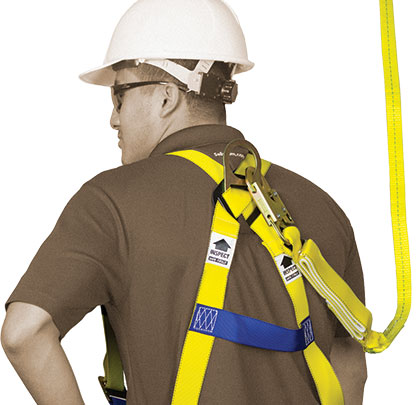We’re not always sure what the jobsite has in store each day, but the statistics tell us that we can expect fall hazards. According to an OSHA news release, in 2013, falls killed 294 of the 796 construction workers who died on-the-job in the U.S. It’s important to have the right tools on hand to keep the project moving along safely.
RELIABLE PROTECTION
As technology and innovative thinking make strides in the construction industry, so does safety equipment. Sometimes, however, it’s important to get back to the basics. Just like a first aid kit, harness and lanyard kits are available to address basic fall hazards. There have been hundreds of new harness and lanyard styles introduced into the market since they were first implemented. All of the new options can seem overwhelming and costly, but it’s possible to purchase a basic harness that offers all the same protection as the more expensive models.
Harness and lanyard kits are available at prices that are better than ever before. Sellstrom, a manufacturer of harness and lanyard kits, is just one example of a company with a few good options up its sleeve. “We’ve worked with our suppliers and our customers to fit their needs while keeping an eye on cost and demanding quality. You don’t need to go across an ocean to fit tight budgets,” says Tom Capalbo, vice president of sales and marketing at Sellstrom. Going back to the harness and lanyard kits might be a step up from the latest and greatest fall safety protection. Aside from being budget friendly and easily accessible, these devices are reliable—so much so, that they’ve been around for years.
COMPLIANCE WITH LATEST STANDARDS
Fall protection standards have been changing as we learn more about how to protect workers. Just because a harness passes inspection, doesn’t mean that it’s the best protection. New standards (ANSI Z359) have placed stronger limits on fall arrest forces and have been reevaluated for the current size/weight of the everyday worker. This means the overall design will provide a softer landing and reduce risk of injury for a broader spectrum for workers. “With the advancements in technology, more data has been obtained in both the aspects of testing and design so that the industry can provide a better solution to the end user,” explains Sellstrom engineering manager, Ken Lemke.
THE RIGHT FIT
Harness fit is important to hold a worker not only during a fall, but also for comfort while working. If the harness fit is uncomfortable, the worker may not wear it. If the harness doesn’t fit properly, it could cause serious injury during a fall. Choosing a harness that is simple to put on and comfortable to wear correctly will improve the likelihood that your workers will make the right choices.
Remember, it’s important that the back D-Ring rests between the worker’s shoulder blades to keep the worker in an upright position when a fall is arrested. The sub-pelvic strap that rests below the buttocks should be placed so that it feels like a seat to support the worker when suspended. The chest strap needs to be placed at the same level as the underarm to keep the shoulder straps together during a head first fall. If the harness isn’t fitting like this, something is wrong and something will likely go wrong during a fall arrest.
WHEN IN DOUBT, THROW IT OUT
Our workers face tough jobs every day, and so does their equipment. It’s important to know when to replace fall protection equipment. You may be familiar with stress indicators on harnesses and lanyards. These are provided to alert the user not to use equipment that has been used in a fall, but just as important is to know when not to use equipment that is past its shelf life. Things like abrasion, dirt, oil, paint, and UV can damage the webbing used in fall protection equipment. The metal hardware can also become damaged or bent during use or storage in a tool box. When inspecting fall protection equipment, always be sure to look closely at the fibers. Bending the webbing in a U shape can help show damage to the webbing. Be sure to check, especially under metal hardware, for signs of wear. Sometimes the equipment can become too soiled to inspect. If the harness or lanyard cannot be cleaned, it’s time for a new kit. Having a supply of harness and lanyard kits on hand will make it easy to replace the equipment and go on with the job.
IS A GOOD COMPANY HARD TO FIND?
When you go looking for that perfect harness and lanyard kit, do your research meticulously. Keep in mind, low cost does not mean that quality has been sacrificed. Sellstrom’s harness and lanyard kits provide a universal fit, back D-Ring attachment, stress indicators, increased gate strength snaphooks, and a low arresting force to comply with the new ANSI Z359.13-2013. Sellstrom still uses Polyester webbing and hardware that meets ANSI Z359.12. Polyester webbing stands up to demanding environments. It has better UV resistance, abrasion resistance, and a higher strength than Nylon. Polyester also absorbs less water. This makes the harness quick drying and more resistant to rot or mildew. Meeting the ANSI Z359.12 standard for hardware means that the snaphooks have higher gate strength, and all snaphooks, O-Rings, D-Rings, and carabiners are 100-percent proof loaded to inspect for unseen defects. Beyond material choices, Sellstrom has a vigorous quality control program. “At Sellstrom, we continually strive for the highest quality products at the lowest possible price,” says Steve Batke, quality assurance manager for Sellstrom. ■
For More Information: Sellstrom has been selling personal safety products since 1923 and has become a leader in the PPE industry with its fall protection equipment, helmets, safety glasses, and more. For more, visit www.sellstrom.com or www.fallprotection.com.
_________________________________________________________________________
Modern Contractor Solutions, August 2015
Did you enjoy this article?
Subscribe to the FREE Digital Edition of Modern Contractor Solutions magazine.

Back to Basics


